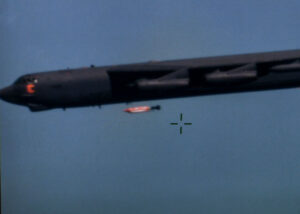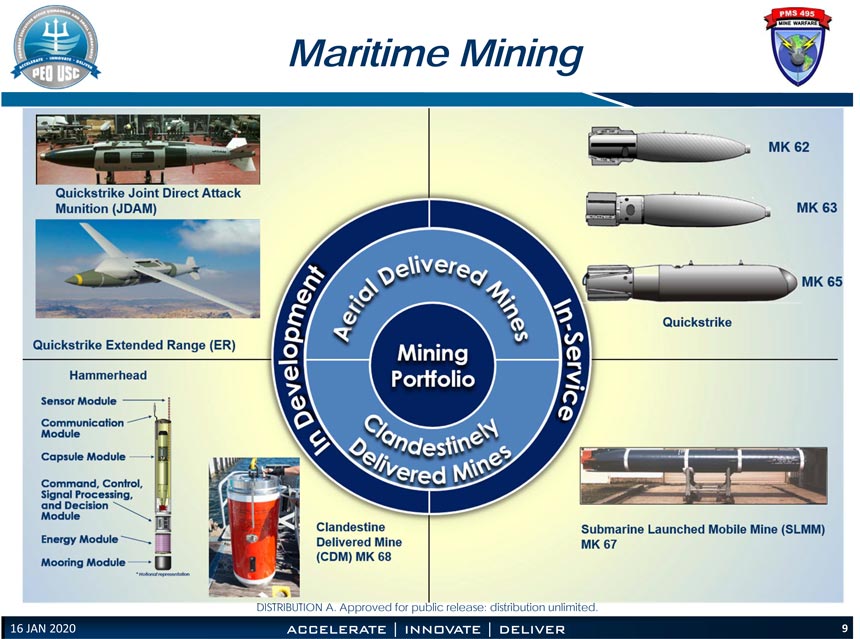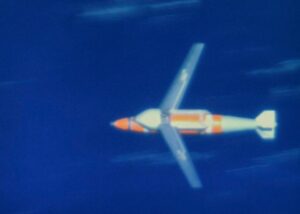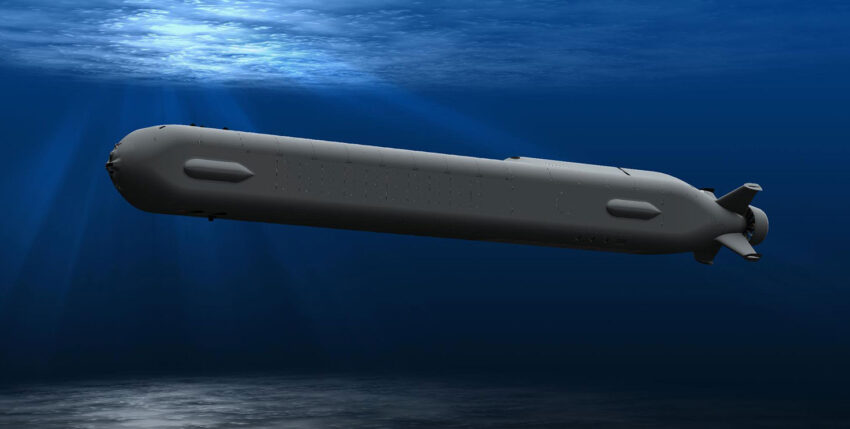The reassessment of the Russian and Chinese naval threat - after three decades of neglect - has reawakened the US Navy's interest in offensive mine warfare. The Navy is now seeking new, more effective methods to dislodge sea mines. This includes the introduction of new mine technology to combat enemy surface ships and submarines.
Offensive mine warfare capability
The current US naval mine inventory consists of the Quickstrike system and the SLMM system (Submarine Launched Mobile Mine) Mk 67. All mines are suitable exclusively for use in shallow waters. All types are remotely detonated mines that react to the acoustic or magnetic signature of enemy ships or to a change in water pressure.
The Quickstrike mine family consists of the mine types Mk 62 (500 pounds), Mk 63 (1,000 pounds) and Mk 65 (2,000 pounds). The Mk 62 and Mk 63 types are free-fall bombs that were converted for use as sea mines. The larger Mk 65 was developed specifically as a mine. Like free-fall bombs, all three types of mine are released by naval reconnaissance aircraft and carrier-based fighter-bombers of the Navy as well as by long-range bombers of the US Air Force. After the weapon is released, a parachute located at the rear of the mine opens to ensure a smooth descent into the water. During these missions, the aircraft involved have to fly at low altitude (150 metres above the sea surface) and at a maximum speed of 320 knots, which is comparatively slow, in order to prevent damage to the mine. However, this places strict limits on the use of mines; mines can only be deployed at a sufficient distance from enemy forces or positions in order to minimise the risk to the carrier aircraft.
The Mk 67 weapon system is deployed covertly by manned fighter submarines. The system consists of a torpedo hull in which a 2,000-pound class mine warhead, an on-board guidance system and a long-life battery are integrated. The weapon is deployed at a sufficient distance to prevent the submarine and the mine from being detected by the enemy. It then travels to the intended deployment zone - such as a harbour mouth or strait - and comes to rest on the seabed. As soon as a passing enemy ship is detected, the warhead is triggered. Placing the mine in a torpedo housing makes it possible to place mines where offensive mine warfare forces would not normally have access. However, the technology, which dates back to the 1980s, is considered outdated. SLMM is to be decommissioned and replaced in the near future.
Quickstrike JDAM-ER
The Quickstrike mine family will remain in service, but will be made significantly more efficient thanks to new technology. This includes equipping the mines with a more powerful target detection system and new sensors for recognising and classifying enemy ships.
However, the equipment of the Quickstrike mines with Joint Direct Attack Munition (JDAM) is more far-reaching. This kit consists of a guidance system mounted at the rear of the free-fall ammunition and a GPS navigation system. This converts free-fall ammunition into precision ammunition.
The sea mines equipped with the simple JDAM armour set are known as Quickstrike-J. JDAM gives the mines an increased flight range and a flat flight angle; this allows the mines to be launched from high altitudes and at high flight speeds.

Quickstrike-ER spend- Image: US Navy
Some of the mines are fitted with the enhanced-performance JDAM-ER armament kit and are designated Quickstrike-ER (Extended Range). In addition to the rear attachment, the JDAM configuration includes a tail unit mounted on the centre of the mine, which significantly increases the flight range even further. Testing of the Quickstrike-J variant to date has shown that the retrofitted mines can be triggered from an altitude of up to 12,000 metres and from a distance of 40 nautical miles from the target area. Thanks to the JDAM's GPS navigation system and the reduced scattering circle of the ammunition of around 10 metres, a bomber or maritime reconnaissance aircraft can deploy a complete minefield in a single overflight. Depending on the enemy's equipment, the increased range means that aircraft may even be able to mine enemy harbours or estuaries from a safe distance.
The multi-year Quickstrike-J/Quickstrike-ER test series was successfully completed in May 2019. The integration of the system is currently being fine-tuned. As the JDAM armour set is already in the US military's inventory, the upgraded Quickstrike system is expected to be introduced in series production next year at the latest. In principle, the technology can also be used by allies who have JDAM-compatible aircraft.
Hammerhead
Despite the flexibility of Quickstrike, however, the future of mine warfare will be characterised by the covert deployment of mines by unmanned underwater vehicles (UUVs), explains Captain Christopher Merwin, head of the US Navy's San Diego-based Mine Warfare Division. UUVs can carry out missions in waters that would be too dangerous for manned units; in addition, due to the difference in size, UUVs would have a better chance of deploying their payload undetected.
The Hammerhead weapon system, which is currently under development, is specifically designed for use by UUVs. Hammerhead is officially referred to as a mine system, as it is deployed on the seabed and waits for enemy units to pass. However, the actual combat payload consists of a Mk 54 light torpedo, and the rest of the system is literally designed and built around the torpedo. A concept image released by the Navy shows that the system is housed in a tubular container and consists of six modules. At the bottom is the anchor module for vertical attachment of the weapon to the seabed. This is followed by the power module - basically a battery for the long-term supply of electricity. The electronic guidance system is attached to this. Next comes the actual payload module with the torpedo, which makes up around two thirds of the total length of the system. Finally, two antennas, known as the communication and sensor module, protrude from it. The modular composition of the system means that Hammerheads in the armoury can be upgraded with the latest technology at any time.

Due to the required operational range and payload capacity, only the particularly large XLUUVs (eXtra Large Unmanned Underwater Vehicle) can be considered as unmanned carrier vehicles. The Navy could acquire up to 50 of these 16-metre-long submarines. The deployed mine anchors itself autonomously to the seabed and remains in a passive state - possibly for months. The weapon system can be activated remotely at any time.
The sensor data is analysed and a detected ship is classified autonomously by the on-board command and control system. If an enemy ship is positively identified, the torpedo is released at the optimum time. Hammerhead can be programmed to respond only to a specific class of ship. According to the Navy, the primary target - at least for the time being - will be enemy submarines. One conceivable operational tactic would be to lure enemy submarines using the same XLUUV that previously released the mines. The Navy has been discussing for years the potential use of underwater drones as decoys that emit the acoustic and electronic signature of manned units to lure enemy hunting submarines out of cover.

Compared to the current mines, Hammerhead is intended to be used preferably in medium to deeper waters. By using a torpedo instead of a conventional mine as the effective munition, Hammerhead can attack targets that do not move into the immediate vicinity of the mine or perform evasive manoeuvres.
The development of the new mining system, which began in 2018, is a priority for the Navy and has been underway since 2019 in accordance with a
accelerated timetable. The formal tender is expected this autumn. Contracts for the design and testing of prototypes are to be awarded during the 2021 fiscal year, which begins on 1 October 2020. Up to 30 units will initially be delivered for testing purposes by the end of 2023.
CDM
A weapon known as the Clandestine Delivered Mine (CDM) is also under development. In contrast to the Quickstrike and Hammerhead development programmes, no technical or operational details of this system are published. Only the immediate programme name reveals that the mine will be covertly suspended. However, a publicly released Pentagon budget document from 2016 indicates that CDM is composed of Mk 67 components. The resulting mine is significantly smaller than SLMM and can therefore - unlike the Mk 67 - also be deployed by medium-sized unmanned underwater vehicles. This increases the flexibility of the US Navy's offensive mine warfare, especially until the Hammerhead system enters service. Prototype testing was carried out in 2019 with the aim of operational CDM deployment during 2020.
Author: Sidney E. Dean











One Response
Testing Comment 2